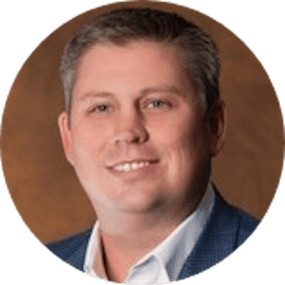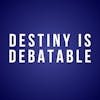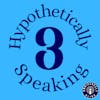Hey, Brian, thanks for joining us on the podcast today to talk about the eSight 4 device. Tell me a little bit about aSight as company when it started and really why it started. I'm sure somebody had a really good idea for this to help people with visual impairment.
Brian McCollum:
Absolutely. It's a pretty interesting story, but let me just say a little bit about eSight. So, eSight, is essentially a company that has developed a leading vision enhancing platform. And if you think about it, you know, the vision enhancing platform in the world, you know, we like to play in that kind of mixed reality versus that augmented reality. And since that means that we want to take what senses you have left, what vision you have left. And we've created a device that we can couple, some, augmented type stuff with what you have. And we've developed a product that basically helps folks dealing with with 20 or so odd conditions, be able to see better. The company is based in Toronto, Canada. We have a manufacturing location in Ottawa, so everything is kind of Canadian made. And we manage our US footprint out of a small office in Nashville, Tennessee.
The original idea for eSight was developed by a gentleman named Conrad Lewis. And he essentially had two sisters who were living with Stargardt's disease. And Stargardt's disease is essentially a central vision loss in a younger population. And he made a commitment to them one day that he was going to create something that they would be able to see and be able to do the things that they wanted to do. And so, he put all of his time and effort into creating a device. They came out with generation one and quickly followed with generation two. And then the company spent, I don't know, several years just kind of retuning and refining the concept and launched what was the previous version eSight 3 about three years ago. And most recently we just launched what we believe is our commercially our most viable commercially product eSight 4.
John:
And for somebody that's not familiar with what eSight is in general terms, what does the eSight 4 do and who is the target user?
Brian McCollum:
Sure. So eSight 4 is essentially a head mounted device that really provides a noninvasive way and a wearable solution that we can help people dealing with visual impairment. Whether that's say 20 over 60 all the way up to say 20 over 800 of people who are legally blind. And what, what the device does is it uses a camera and the front of the, of the device. And it runs an image through a set of software algorithms and projects, images onto two screens inside the headset. And what it really does is, is it takes the light and puts light and more stimulus into what's left of the users photo receptors, et cetera, and allows them to fill in any, any blurry spots, any black holes, any gap they may have in their vision by essentially tricking the brain that there's more information coming into it.
John:
And what are the key or the best or improved features from the eSight 4 device from its predecessor?
Brian McCollum:
So, if you think about the evolution of the eSight product the, the concept of, can you use a camera run off and then run a software system with algorithms and project something into screens that actually improve vision of low vision individuals was what was founded and the original product kind of proved that I would say eSight three, took it a step further and say, Hey, can you actually now create a device that some people will actually wear and be able to use? We had that product in the market for about three years and did a, an enormous amount of user evaluation testing, a lot of feedback from, I mean, you know, we have a home demo experience program, so where we're sending a lot of these units out, we're getting any enormous amount of feedback of what people like and what they don't like.
And so the key, the key design changes for eSight 4 are really around three kind of main topics. One is mobility. The second one is around comfort and the third one is around ease of use. And I'm happy to dive into each one of those. But if you think about eSight 3 it was a, it looked more like a glass as it kind of hung on the head with a strap and it had a remote that was tethered by a wire that was essentially the battery. So you were not completely wireless if you will. And that battery within that remote needed to be charged every couple of hours or three hours or so. And what we did with eSight 4 is we made it 100% wireless. It is got interchangeable batteries that charge, and they can be charged outside of the device.
They are hot swappable. So if you have one and your battery is running low at about two and a half, three hours, basically pop it out and pop another one in and you can kind of not ever have that downtime of recharging. The second item was more about comfort. And if you think about how we designed the eSight 4 there's a halo that sits on top of the head. And as you can imagine, when we made it 100% wireless we had to put the battery in the headset. So obviously that added weight to, but the way it's distributed with the battery in the back and the way the halo sets right on the head, the feedback has been tremendous that the device is way more comfortable. We even have coaches internally who help people navigate the device who wear this device for up to eight hours a day.
And they've told us it's definitely more comfortable. And then the third one was, you know, these are complex devices and they probably do a hundred things that someone's never really going to dive into or learn or want to need to learn or to dive into. We needed to make it more simple. We needed to make the user interfaces. We need to make it more intuitive because you're dealing with a range group that can go from our youngest patients four all the way up to 104. We needed something that was easy to use. And, this product hits the mark. We are able to put this product into what we call live view mode. When you flip it on, within about 45 seconds, the screen is up, you set the pupil distances on the screens inside the headset. And someone knows within a matter of two or three minutes, if this device actually is going to help them see, and those three things are really what sets eSight 4 apart.
John:
You mentioned some feedback, user feedback. It looks like on your website, which is
esighteyewear.com. There are some testimonials as well as some feedback and frequently asked questions. But something that I want to know is what are the most common tasks that you're hearing from users that are just makes life easier while using the eSight 4 device?
Brian McCollum:
Yes. So it really depends on what they want to do, right? You know, tasks that are a student has different tasks that they want to perform versus say, a retired person who maybe wants to use it to watch TV, etc. Where we see the people who value the device the most is where those people want to be mobile. They want to be on the go. Our device has a feature called bioptic tilt. And what it allows you to do is essentially keep your peripheral vision if you have it which is what allows you to stand and balance and move around. It allows you to, to keep that, and then you can put the device over your eyes. You can pull the visor down over your eyes if you need it, or if you don't need it. And you're in a situation you just want to flip the visor up.
To me that allows this group, whether it's a student going from class to class, or whether it's a working professional sitting in a meeting who needs to look at a projector or look at a presentation, but at the same time wants to have eye contact with people sitting around the table because we've heard that that's an important concept. So it really depends on what they're trying to get out of it. I would definitely say though, mobility the all day battery life that we, you know, because we can have two or three batteries that could essentially get someone through an all day shift. If you think about someone working an eight hour shift in a factory or something they now have the ability in a device that they don't have to worry about running out of power or having to go to an outlet that charges somewhere, as long as they've got enough batteries, they're able to just pop in and out.
And, and then if you think about that, you know, we all think, Oh, well, there's, there's this population that they want to use it to watch TV. And there are right. There are a lot of people who want to use it to watch TV. They want to use it to play gaming systems, etc. But a lot of those people also want to have the mobility. They don't just want to be confined to sitting in front of their TV if they don't have to. And so, yeah, while they'll use it to do some of those things we find that the people who want to try to somewhat remain mobile is really where it appeals to.
John:
I imagine there's a pretty strong and core group of engineers or programmers that work on this device, is that all done in Canada?
Brian McCollum:
It is. So if you think about eSight and our product, and if you think about other wearables in the space we've taken the approach that we want to develop our own hardware, as well as our own software platform. And so those two things take two different skill sets, right? You've got engineers, you can't just have software engineers or electrical engineers. You've got to have mechanical engineers. And so we've got a team of both we've got one team working on the hardware component. So whereas some of our competitors may go out and say, well, let's just go buy a device from a manufacturer. Those manufacturers have those mechanical engineers, but their product is limited on what software can actually be put on that device. It's also limited to what features and how we change the mechanical side of our device. Like, does it do this? Does it do that? Does it flip up? Does it flip down? How do you adjust it? And so we believe we have built a core competency in both the hardware and the software side. And so for us, we believe it gives us a great platform to be able to not only develop products for the low vision space, but to develop products that where near eye optics come into play. And that could be a surgeon using it in a surgical setting or in any, any situation to where you need to have something that's close up from a near eye perspective. You need an auto-focus, you need zoom capability, maybe you need a light source. So, so we, we definitely believe we've created a group that can take this product and do other things with it also while continuing to improve it for that low vision individual,
John:
With the integrated approach that you guys take for developing the product and coupled with the wireless abilities in the eSight 4 device, are there updates or firmware changes that we could see down the road that would improve the site for device beyond?
Brian McCollum:
Yes, and that's, that's the beauty of this device and the way it was created it, every software update, you know, patch that's required, feature improvement that we believe is beneficial to the population is all going to get pushed over a WiFi connection. So these devices connect to the WiFi. They're going to kind of run out of, they're never going to be outdated. If that makes sense. You know, when people, when people take and they say, Hey, this device works for me and they make a decision to spend the money to, to have this device for themselves. We don't think that that should run out right. We don't think that they should be two or three years from now having to buy the latest and greatest product. Now, if it's, if we create a product like we did with eSight for that is so different and so much better, several of them are going to want to upgrade from a hardware perspective, but we don't believe they should initially have to upgrade from a software perspective.
John:
Alright, let's talk about availability and pricing, now. If somebody is interested in getting their hands on one of these, what's the best way to do that?
Brian McCollum:
Well, the best way to do it is to, is to go to our website esighteyewear.com. And we have a program to where we will send this unit out to them. We'll actually go through a screening. So let me rewind a second. We'll go through a screening process. We'll talk about their condition. We'll talk about, you know, their field of view. We'll talk about different things that are specific to them. And if they pass that screening process, because this product doesn't work for everyone. And we, you know, we have certain conditions that we work better with. And there are certain conditions that it's, you know, it's a 50 50 proposition. It really depends on, on their unique situation, light getting into their eyes, et cetera. And so we'll go through a screening process if they pass the screening process there's a home demonstration program that we have, they can for $99, they can, they can get the device into their home.
They can use it in their setting for seven days. And then depending on that, they can make a decision where to purchase it. We also have a growing network of distributors and representatives around the country. And so in some States we've taken the approach that, Hey, we want to have that hands on experience. We want them, we want someone to be able to walk into their home or walk into a clinic setting and show them device and really, and really take them through it to see if it's the right choice for them. So I would say reach out to us via our website and we'll get them into the right contact with the right person, if they choose to this really works for them. I love it. I want to buy it. That's great. You know, we're, we're, we're proud in the sense that we're able to offer this device with as many improved features and the feedback that we're getting, it's the same price as the previous version.
And so that's, it's $5,950. But we really have a lot of programs. We have an, empower program to where we have two people on staff who help people fundraise. It's 100% of the proceeds go directly to the purchase of the device. So there's no kind of administration fee. And we are also making some very good headway with some insurance companies. And so we've actually signed three contracts with some repricing networks that cover lives throughout the United States. And we believe if you look at eSight 4 it, we believe it's a true medical device and that, yes, it's improving quality of life, but it's also preventing future health issues that could occur in this population. And so we're beginning to get an audience with those folks. And so if we can get insurance companies to recognize the value, we have an enormous push now to really reach out and educate the clinician population, the professional population, and the sense that we want, the ophthalmologist and optometrist to know, Hey, this device, yes, it's been out, but this is our new device. And these are the things it does, and it can help your patients. We, we think getting those people to understand what the product does and what it is will help us make it more accessible to these folks.
John:
So it sounds like through the assessment program and the trial period, as you said, this device is not for everyone it sounds like you're going to weed out all the ones that it doesn't fit for. And by that, by the time you make it through that process you're pretty much locked and loaded and know this device will, will make life easier for you.
Brian McCollum:
That's correct. So if, if they get it, they, you know, it's, there's some value to, there's some value as just having people try this in their home and their setting that they want to do, right. Whether it's the, watch their TV or read to their kids, or go out and walk in their yard, as opposed to doing it in say an optometrist office, right? It's a, it's a sterile environment in the sense that everything's kind of bright and, you know, it's, it's one thing to have it work in your, your own personal setting. And so look, it's, we, we think like there are other wearables on the market. And if, and I would say, you really don't know, and I, and I hear this from people who try them and influencers and different things is there's them, there's a device out there that will probably work for you.
We've tried to create a device that if our device is what works for you, we want you to love the device. Like we want you to love the features of it. We want you to love that you can just throw a battery in and throw a couple in your bag and know you're not going to run out. We want you to know that you're able to walk around with it on. And so it's up to us to develop a product that we, that we want to make you love. And then, and then it comes down to sometimes to, Hey, you know, can I afford it? And do I see the benefits? And do they, the benefits outweigh the costs. And I would just say from, from our perspective we want to get products that work in the hands of people that can be helped. And if our product does that, that's great. If someone else product does that, we want them to have that product because that's the last thing we want to do is for someone to say, I love the product. It doesn't really work, but I wanted anyway, that doesn't do anyone any good to be quite honest.
John:
Yeah. It sounds like the eSight 4 device is pretty exciting, Brian. Thanks for your time again. Is there anything we've missed?
Brian McCollum:
No, I don't think so. I, John, I appreciate the opportunity to just talk about eSight 4 and eSight a little bit. And you know, it's at a very exciting time to be honest. I'm I've only been at the company right at six months. We've got almost a completely new team. And we, we believe we've got something that is truly game changing and not only is it game changing from the perspective of, yes, there's a lot of feel, good stories that come from this type of stuff, but we believe we now have a, a business case or an economic case that we can make to whether that's companies looking to use this as technology they deploy in their workplace students. I mean, there's a lot happening today. You're reading a lot about people having to take classes from their dorm room. Well, there's a population that gets left behind or potentially left behind in those situations. And so we, we, we want to start making the case for this device is something people should consider because it makes business financial sense, not just because it's a feel good story. And I think if we can make that change I think we'll do a lot of we'll add a lot of value to, to this population we're trying to serve.
John:
Okay. And once again, the website
esighteyewear.com, do you know, is there a phone number that corresponds to that for somebody that just wants to dial?
Brian McCollum:
Yes. You can find us at
esighteyewear.com or you can call 1-855-837-4448 again, 1-855-837-4448.
John:
Once again. Thanks a bunch, Brian!















